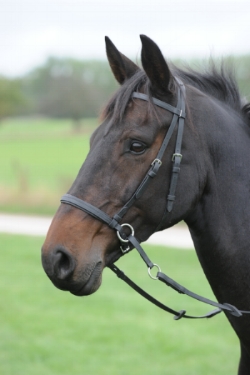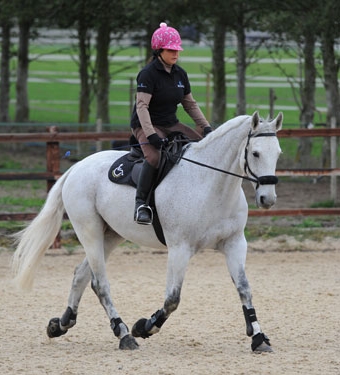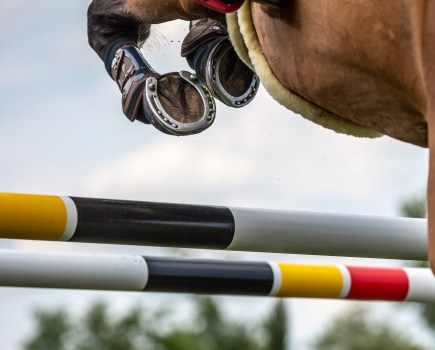Here, our resident scientist, Ilse, reviews the science behind the bitless bridle trend
The popularity of bitless bridles has been on the increase in the last few years, with many riders opting to use them in the hopes of being kinder and more humane.
However, beyond anecdotal and personal preference, there have been relatively few studies directly comparing the effects of bitless vs traditional bridles on the comfort of our horses.

Bitless bridles are becoming increasingly popular, with a drive to have them declared Dressage legal.
In a study as part of a master’s degree, researchers compared the behaviour of horses when ridden at preliminary level dressage in bitless and traditional bridles.
The same rider rode each of the 12 horses through the same test twice; once in each of the bridles.
From videos of the tests, the researchers identified six negative behavioural markers (“tail swish, open mouth, cow kick, hollow, fall out and pull down”), and graded how often the horses did these behaviours in the bitless vs their regular bridles.
They found that the horses were actually more likely to perform these negative “conflict” behaviours in the bitless bridles.
While a good start, clearly this study has some drawbacks. For a start the results could be due to the influence of the rider; perhaps they were unfamiliar with the bitless bridle.
The same goes for the horses; if it was the first time they’d been ridden in the bitless bridle, then they’re more likely to show unsettled behaviour than they are in their familiar tack.
Also, this study is potentially open to bias as the researchers scoring the videos could clearly see which bridle the horse was wearing.
Another, much more recent study was presented at the 2017 International Society for Equine Science in November.

Some riders prefer bitless compared to bitted bridles
In this study, researchers compared the effect of rein pressure of six bridle-bit combinations (Bitless: LG-bridle®, Dr Cook’s BitlessBridle®, Fred Rai Rope®, Sidepull; Conventional: rope halter, bridle with a single-jointed snaffle bit) that a horse was comfortable with.
The 21 horses in the study were each fitted with a roller and a rein tension meter that the reins were attached to.
The reins were long enough to allow the horses to have their heads 5-10º in front of the vertical, simulating the position of a rider’s hands.
The rein tension meter allows for a measure of the force the horse is pulling on the reins with. Horses were lured with food to get them to stretch their necks out, effectively pulling against the reins.
The experiments were stopped either when the horses had attempted to reach the food and had stopped pulling on the reins, or after one minute for the more determined horses!
They repeated this experiment with each bridle on each horse three times a day for three days in a row in order to account for any effects of unfamiliarity of the tack.
The researchers did a statistical analysis to see if there were significant differences in the amount of tension a horse was willing to put on the reins in each of the different types of bridle.
The thinking being that if the bridle is kinder, the horse will be willing to put more tension on the reins because it’ll be causing him less discomfort.
Accounting for differences among horses, the order in which the bridles were tried and the testing days, the researchers found that, with the exception of the Sidepull, horses put the same amount of tension on the reins regardless of the bridle type.
Horses were less willing to pull against the Sidepull design of bitless bridle. This finding suggests that the bitless bridle may not, as might be expected, be kinder to the horse because it can still put a substantial amount of pressure on the nose and poll of the horse, with the amount of force depending on the bridle design.
These two studies suggest that we might not be making things substantially more comfortable for our horses by using bitless bridles.
In some cases we may be making things worse, but at the end of the day our horses are all individuals and very often their riders will know best what tack suits their horses.
Some horses may prefer a straight-bar snaffle, some a jointed loose-ring link while others may well prefer the bitless bridle.
I think we all agree that the most important thing is that we treat our horses on an individual basis and are sensitive to their needs and preferences.
We must remember too, that so long as the horse isn’t suffering, how another rider wishes to tack their horse is up to them and perhaps refrain from commenting where comments are unnecessary!
Further reading for the two studies quoted here:
Masters thesis: “Comparison of behaviour exhibited by horses ridden in conventional bitted and bitless bridles”, by R. M. Scofield at the University of Plymouth
Conference proceeding: “Horses’ voluntary acceptance of rein tension with various bitless bridles compared to a single-jointed snaffle bit”, M. Kubiak, A. Vogt, H. Sauter, J.W. Christensen, U. König von Borstel, presented at the 13th International Equitation Science Conference, November 2017








